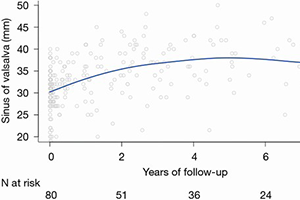Ross operation after failure of aortic valve repair
Abstract
Background: Repair failure remains one of the most important complications of aortic valve reconstruction. Young patients might benefit from a Ross procedure in such a scenario, provided it can be performed safely and with adequate durability. The aim of this study was to assess the safety and clinical outcomes of a Ross operation following a failed repair.
Methods: Between 1996 and 2019, 80 patients (male, 76%; mean age, 31±13 years) underwent a Ross procedure after a median of 6.6 (1.7–15.9) years following an initial aortic valve repair. The previous valve repair was performed for unicuspid (53%), bicuspid (39%), tricuspid (7%), and quadricuspid morphology (1%). Median follow-up after the Ross operation was 2.8 (0.964–13.25) years, mean 5±5 years (92% complete).
Results: Median cardiopulmonary bypass and cross-clamp times were 144 [106–154] minutes and 98 [79–113] minutes, respectively. Thirty-two patients (40%) required a concomitant procedure, most commonly, an ascending aortic replacement (n=23). There were no peri-operative deaths, myocardial infarctions, or neurological complications. There was one late death from a non-cardiac cause. At 10 years, overall survival was 99%±1%, similar to that of an age- and gender-matched population. Nine patients required re-intervention after their Ross procedure (five on the autograft and four on the pulmonary conduit). The autograft re-interventions were valve-sparing procedures in all patients. The cumulative incidence of re-intervention on the autograft at 8 years was 5.1%±3.1%.
Conclusions: The stepwise strategy of an initial valve repair followed by Ross operation represents a safe and valid option for failed aortic valve repair. It is associated with low peri-operative morbidity. Mid-term survival is excellent, similar to that of a matched general population. The probability of re-intervention after the Ross procedure appears similar to that of a primary Ross operation, deeming it a warranted consideration in cases of failed aortic valve repair.
Cover






